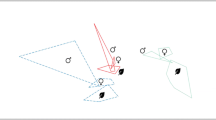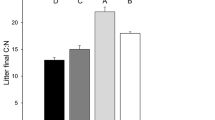Summary
-
1)
In three species of terrestrial isopods the rate of ingestion of litter decreases but the efficiency of assimilation increases with rising concentrations of copper in the food.
-
2)
When feeding on natural litter with a low concentration (20 ppm) of copper at 22°C, all three species of isopods tested lose more copper through their feces than they ingest. When fed artificially enriched litter, the efficiency of assimilation increases strikingly so that at the highest concentration of copper tested (5200 ppm) between 80 and 90% of the ingested metal is assimilated.
-
3)
At 8°C copper balance of isopods never becomes negative, not even with the lowest concentration of copper in the food.
-
4)
Both types of experiment indicate that the more slowly food passes through the gut the more efficient is the digestive system of the isopods in extracting copper from it.
-
5)
Isopods are capable of digesting even tightly bound copper during one single passage of food through the gut. However, they are unable to resorb more copper than they lose unless the food is enriched with soluble copper or the rate of food passage through the gut is slowed down. This deficiency in the process of resorption is likely to be the reason for coprophagy in this group of animals.
-
6)
When feeding on litter not in an advanced state of decay, the isopods arehyperphagous. This may have the—teleological—advantage that organic material is more rapidly converted into feces by the isopods and thus prepared for the attack of microorganisms.
Similar content being viewed by others
References
Berthet, J., Berthet, P.: Présence de l'hémocyanine dans l'hémolymphe des Isopodes et des Amphipodes. Arch. Int. Physiol. Bioch.71, 124–125 (1963)
Brown, N.A., Hemingway, R.G.: A rapid method for the determination of copper in biological tissues by means of zinc-dibenzyldithiocarbamate. Res. vet. Sci.3, 345–347 (1962)
Gere, G.: The examination of the feeding biology and the humificative function of Diplopoda and Isopoda. Acta Biol. Hungar.6, 257–271 (1956)
Hartenstein, R.: Histochemical and spectrophotometrical studies on several dehydrogenases of carbohydrate metabolism inOniscus asellus. Insect. Physiol.10, 623–631 (1964)
Hassall, M., Jennings, J.B.: Adaptive features of gut structure and digestive physiology in the terrestrial isopodPhiloscia muscorum (Scopoli 1763). Biol. Bull.149, 348–364 (1975)
Neuhauser, E., Hartenstein, R.: Degradation of phenol, cinnamic and quinic acid in the terrestrial crustacean,Oniscus asellus. Soil Biol. Biochem.8, 95–98 (1976)
Newell, R.C., Wieser, W., Pye, V.I.: Factors affecting oxygen consumption in the woodlousePorcellio scaber Latr. Oecologia (Berl.)16, 31–51 (1974)
Phillipson, J.: Ecological energetics, pp. 57. London: Arnold 1966
Priesner, E.: Nahrungswahl und Nahrungsverarbeitung bei der Larve vonTipula maxima. Pedobiol.1, 25–37 (1961)
Walker, G.: “Copper” granules in the barnacleBalanus balanoides. Mar. Biol.39, 343–349 (1977)
White, J.J.: Bio-energetics of the woodlouseTracheoniscus rathkei Brandt in relation to litter decomposition in a deciduous forest. Ecology49, 694–704 (1968)
Wieser, W.: Untersuchungen über die Ernährung und den Gesamtstoffwechsel vonPorcellio scaber (Crustacea: Isopoda). Pedobiol.5, 304–331 (1965)
Wieser, W.: Copper and the role of isopods in degradation of organic matter. Science153, 67–69 (1966)
Wieser, W.: Aspects of nutrition and the metabolism of copper in isopods. Am. Zoologist8, 495–506 (1968)
Wieser, W., Busch, G., Büchel, L.: Isopods as indicators of the copper content of soil and litter. Oecologia (Berl.)23, 107–114 (1976)
Wieser, W., Klima, J.: Compartmentalization of copper in the hepatopancreas of isopods. Mikroskopie24, 1–9 (1969)
Wieser, W., Makart, H.: Der Sauerstoffverbrauch und der Gehalt an Ca, Cu und einigen anderen Spurenelementen bei terrestrischen Asseln. Z. Naturfschg.16b, 816–819 (1961)
Author information
Authors and Affiliations
Additional information
Supported by the “Fonds zur Förderung der wissenschaftlichen Forschung in Österreich”, project no. 2851
Rights and permissions
About this article
Cite this article
Dallinger, R., Wieser, W. The flow of copper through a terrestrial food chain. Oecologia 30, 253–264 (1977). https://doi.org/10.1007/BF01833632
Received:
Issue Date:
DOI: https://doi.org/10.1007/BF01833632




